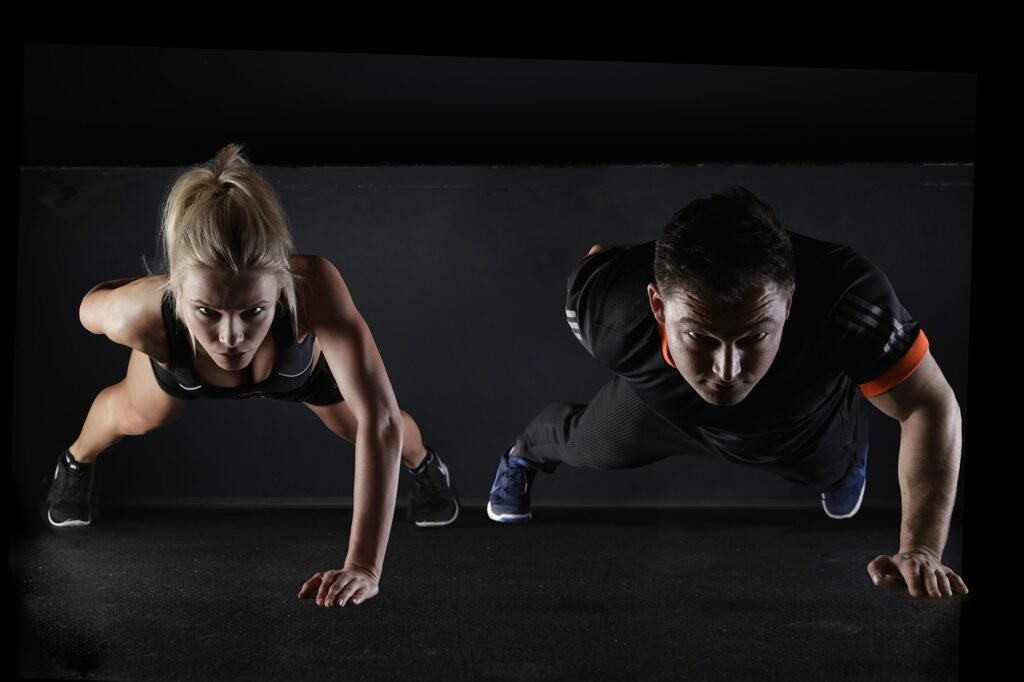Maximize Your Workout with High-Intensity Interval Training Plans
Are you tired of spending hours at the gym with minimal results? If so, it’s time to discover the power of High-Intensity Interval Training (HIIT) plans. By combining bursts of intense exercises with short recovery periods, HIIT allows you to maximize your workout in a fraction of the time. Whether you’re a beginner or a seasoned fitness enthusiast, HIIT plans are designed to push your limits, increase your endurance, and burn more calories. Say goodbye to boring and monotonous workouts and say hello to a more efficient and effective way of achieving your fitness goals. Get ready to transform your body and take your workouts to a whole new level with HIIT plans.

This image is property of pixabay.com.
What is High-Intensity Interval Training (HIIT)?
Definition of HIIT
High-Intensity Interval Training (HIIT) is a workout style that alternates between intense bursts of exercise and short recovery periods. It involves pushing your body to its maximum effort for a short time, followed by a quick rest. This cycle is repeated multiple times during a workout. HIIT workouts are known for their effectiveness in burning calories, improving cardiovascular fitness, and building strength.
Benefits of HIIT
One of the main benefits of HIIT is its efficiency. Unlike traditional workouts that involve spending long hours at the gym, HIIT workouts are typically shorter, ranging from 15 to 30 minutes. Despite the shorter duration, HIIT can provide the same or even greater benefits as longer workouts.
Another advantage of HIIT is its ability to burn a higher number of calories in a shorter amount of time. The intense bursts of exercise in HIIT workouts elevate your heart rate and metabolism, resulting in increased calorie burn even after the workout is over. This effect, known as the afterburn effect or excess post-exercise oxygen consumption (EPOC), allows you to continue burning calories hours after your workout.
HIIT also improves cardiovascular fitness by challenging your heart and lungs. The intense intervals force your body to adapt and improve its ability to deliver oxygen to the working muscles. Over time, this can lead to increased endurance and a stronger cardiovascular system.
Additionally, HIIT has been shown to enhance metabolic rate. The intense nature of HIIT workouts can increase the production of certain hormones that regulate metabolism, resulting in a more efficient calorie-burning process. This effect can be particularly beneficial for individuals trying to lose weight or maintain a healthy body composition.
Lastly, HIIT workouts can help with muscle building and toning. The high-intensity exercises engage multiple muscle groups simultaneously, leading to increased muscle activation and growth. Additionally, the short recovery periods between intervals can improve muscular endurance and promote muscle definition.
How HIIT works
HIIT works by challenging your body to adapt to intense bursts of exercise followed by periods of rest or low-intensity activity. During the high-intensity intervals, you push your body near its maximum effort, elevating your heart rate and activating multiple muscle groups. This intense effort stimulates your cardiovascular system and triggers the release of hormones that promote fat burning and muscle growth.
The recovery periods allow your body to partially recover before the next high-intensity interval. This active recovery, often consisting of low-intensity exercise or complete rest, helps to lower your heart rate and allows your body to remove waste products and replenish energy stores, preparing you for the next intense interval.
By repeatedly alternating between intense exercise and recovery periods, HIIT workouts create a challenging and efficient training stimulus. This constant variation keeps your body guessing and prevents adaptation, allowing you to continue making progress and improving your fitness level.
Key Components of a HIIT Workout
Warm-up
A proper warm-up is essential before diving into a HIIT workout. It helps to increase body temperature, improve muscle flexibility, and prepare your cardiovascular system for the upcoming intense intervals. A warm-up should consist of dynamic movements that target major muscle groups and mimic the exercises you will perform during the workout. This can include exercises such as arm circles, leg swings, high knees, and jumping jacks. Aim for a duration of 5 to 10 minutes to adequately warm up your body.
High-Intensity Intervals
The high-intensity intervals are the core of a HIIT workout. These intervals involve performing exercises at near maximum effort for a specific duration. The exercises selected should engage multiple muscle groups and elevate your heart rate. Examples of high-intensity exercises include burpees, sprints, jump squats, and mountain climbers. The duration of each interval can vary based on your fitness level and goals, but typically ranges from 20 to 60 seconds.
Recovery Periods
Recovery periods are crucial in allowing your body to rest and recover between intense intervals. These periods can consist of low-intensity exercise, such as walking or slow jogging, or complete rest, where you simply catch your breath and prepare for the next interval. The length of recovery periods should be shorter than the high-intensity intervals to maintain the intensity of the workout. Typically, recovery periods range from 10 to 60 seconds.
Cool Down
To complete your HIIT workout, it is important to include a proper cool down. The cool down allows your heart rate to gradually return to its resting state and helps prevent the buildup of lactic acid in your muscles. It should include static stretches that target major muscle groups, as well as exercises that promote relaxation and recovery. Aim for a cool down duration of 5 to 10 minutes to adequately transition your body back to a resting state.

This image is property of pixabay.com.
Planning Your HIIT Workout
Setting Goals
Before starting a HIIT workout, it is essential to set clear goals. By defining what you want to achieve, whether it’s weight loss, improved cardiovascular fitness, or muscle toning, you can tailor your HIIT workout plan to align with your specific goals. Setting realistic and measurable goals will help keep you motivated and ensure that you are making progress.
Choosing Exercises
When selecting exercises for your HIIT workout, it is important to choose movements that engage multiple muscle groups and elevate your heart rate. This allows you to maximize the effectiveness of your workout and target different areas of the body simultaneously. Some popular HIIT exercises include high knees, jumping lunges, push-ups, and squat jumps. Remember to choose exercises that you enjoy and that are appropriate for your fitness level.
Determining Work-to-Rest Ratios
The work-to-rest ratio refers to the duration of the high-intensity intervals compared to the recovery periods. This ratio can vary depending on your fitness level and goals. If you are a beginner, you may start with a work-to-rest ratio of 1:2, meaning that your recovery period is twice as long as your high-intensity interval. As you progress, you can decrease the rest time and increase the work time to challenge your body further. Experiment with different ratios to find what works best for you.
Creating a Schedule
To ensure consistency and progress, it is important to create a schedule for your HIIT workouts. Determine the number of sessions per week that align with your goals and availability. Aim for a minimum of 2 to 3 sessions per week to see results. Additionally, consider alternating HIIT with other forms of exercise, such as strength training or steady-state cardio, to maintain a well-rounded fitness routine.
Benefits of HIIT
Efficiency and Time-Saving
One of the most significant benefits of HIIT is its efficiency. While traditional workouts can take an hour or more, a HIIT workout can be completed in as little as 15 to 30 minutes. This time-saving aspect makes HIIT a popular choice for individuals with busy schedules or those who prefer shorter, more intense workouts.
Increased Caloric Burn
HIIT workouts are highly effective in burning calories. The intense, full-body exercises performed during high-intensity intervals elevate your heart rate and increase your metabolic rate. This increased calorie burn can help with weight loss or weight maintenance, especially when combined with a balanced diet.
Improved Cardiovascular Fitness
Through its intense intervals and active recovery periods, HIIT workouts challenge and improve cardiovascular fitness. HIIT can increase your heart’s efficiency in delivering oxygen to the working muscles, leading to improved endurance and stamina. Regularly incorporating HIIT into your fitness routine can enhance your cardiovascular health and reduce the risk of certain diseases, such as heart disease.
Enhanced Metabolic Rate
HIIT workouts have been shown to increase metabolic rate both during and after exercise. The intense nature of HIIT stimulates the production of certain hormones, such as human growth hormone (HGH) and catecholamines, which can lead to a higher metabolic rate. This can result in increased fat burning and improved body composition.
Muscle Building and Toning
HIIT workouts are not only effective in burning fat and improving cardiovascular fitness, but they also promote muscle building and toning. The high-intensity exercises engage multiple muscle groups simultaneously, stimulating muscle growth and strength development. Regularly incorporating HIIT into your fitness routine can help you achieve a lean and toned physique.

This image is property of pixabay.com.
Sample HIIT Workout Plans
Beginner HIIT Workout Plan
If you are new to HIIT, it is essential to start with a beginner-friendly workout plan. Begin with a 5-minute warm-up, consisting of dynamic stretches and light cardiovascular exercises. Follow it with 10 rounds of 30 seconds of high-intensity exercise, such as jumping jacks or squat jumps, followed by 60 seconds of rest. Finish with a 5-minute cool down, focusing on static stretches and deep breathing exercises.
Intermediate HIIT Workout Plan
For those who have experience with HIIT and are looking to progress further, an intermediate workout plan can be challenging yet achievable. Start with a 5-minute warm-up, combining dynamic movements and light jogging. Perform 15 rounds of 40 seconds of high-intensity exercise, such as burpees or mountain climbers, followed by 40 seconds of rest. Conclude with a 5 to 10-minute cool down, incorporating static stretches and relaxation techniques.
Advanced HIIT Workout Plan
If you are already fit and ready for an intense challenge, an advanced HIIT workout plan can take your fitness to the next level. Begin with a 10-minute dynamic warm-up, including exercises that target major muscle groups and elevate your heart rate. Perform 20 rounds of 45 seconds of high-intensity exercise, such as sprinting or kettlebell swings, followed by 30 seconds of rest. Cool down with 10 minutes of static stretching and mindful meditation.
Safety Considerations for HIIT
Consulting with a Medical Professional
Before starting a HIIT workout or any exercise program, it is crucial to consult with a medical professional, especially if you have any underlying health conditions. They can assess your fitness level and provide guidance on how to safely incorporate HIIT into your routine. It is particularly important to seek medical advice if you have a history of heart problems, joint issues, or other chronic conditions.
Proper Technique and Form
To ensure safety and effectiveness during a HIIT workout, it is essential to maintain proper technique and form. This includes using the correct posture, aligning your joints, and engaging the appropriate muscles. Performing exercises with improper form can increase the risk of injury and limit the benefits of the workout. If you are unsure about the correct technique, consider working with a qualified fitness professional to guide you.
Listening to Your Body
While the intensity of HIIT is designed to push your limits, it is important to listen to your body and respect its limits. If you experience severe pain, dizziness, or difficulty breathing during a HIIT workout, it is crucial to stop and rest. Pushing through intense discomfort can increase the risk of injury and have negative effects on your overall well-being. Always prioritize your safety and well-being during exercise.
Avoiding Overtraining
HIIT workouts can be intense and physically demanding. It is important to allow your body enough time to recover between workouts to avoid overtraining. Overtraining can lead to a plateau in progress, decreased performance, and increased risk of injury. Listen to your body’s signals and incorporate rest days into your schedule. Additionally, ensuring an adequate diet, hydration, and sleep will support the recovery process and help you get the most out of your workouts.
Tips for Maximizing Your HIIT Workouts
Challenge Yourself with Intensity
To maximize the benefits of HIIT, it is important to challenge yourself by increasing the intensity of your workouts over time. This can be achieved by increasing the resistance, speed, or duration of the high-intensity intervals. Pushing your limits and continuously striving for improvement will help you achieve better fitness results.
Mixing Up Exercises and Intervals
To keep your HIIT workouts interesting and prevent boredom, it is beneficial to mix up the exercises and intervals you perform. This variety challenges different muscle groups, prevents adaptation, and keeps you mentally engaged. Experiment with different exercises, change the order of intervals, or try new equipment to keep your workouts exciting and effective.
Adding Resistance or Weight
Adding resistance or weight to your HIIT workouts can further enhance muscle building and strength development. This can be done by using resistance bands, dumbbells, kettlebells, or bodyweight vests during the high-intensity intervals. The added resistance increases the challenge and stimulates muscle growth. Start with lighter weights and gradually increase as your strength and technique improve.
Tracking Progress and Adjusting Intensity
To gauge your progress and ensure continuous improvement, it is helpful to track your HIIT workouts. Keep a record of the exercises, intervals, and rest periods, as well as the number of repetitions or total workout duration. Regularly assess your performance and adjust the intensity, duration, or number of intervals as needed. This allows you to tailor your workouts to your fitness level and goals.
HIIT vs. Other Exercise Programs
Comparison with Steady-State Cardio
HIIT and steady-state cardio are two different exercise programs that offer unique benefits. Steady-state cardio, such as jogging or cycling, involves maintaining a consistent intensity for a prolonged period. While steady-state cardio is effective in improving cardiovascular fitness and burning calories, it may not be as time-efficient as HIIT. HIIT provides similar or greater cardiovascular benefits in less time and offers the advantage of increased calorie burn through the afterburn effect.
Comparison with Strength Training
Strength training focuses on building muscle strength and size through resistance exercises, such as weightlifting. While HIIT workouts can incorporate some resistance exercises, the primary focus is on cardiovascular fitness and calorie burn. Strength training is essential for developing muscular strength and hypertrophy. Combining HIIT with strength training can provide a well-rounded fitness routine that addresses both cardiovascular health and muscle development.
Frequently Asked Questions (FAQs) about HIIT
Is HIIT suitable for beginners?
Yes, HIIT can be suitable for beginners, but it is important to start at an appropriate fitness level and progress gradually. Beginners can modify the intensity and duration of exercises and increase the rest periods to accommodate their fitness level. Consulting with a fitness professional can help ensure a safe and effective start to a HIIT program.
How often should HIIT workouts be performed?
The frequency of HIIT workouts depends on your fitness level and recovery abilities. Starting with 2 to 3 sessions per week is a good starting point for most individuals. As you progress, you can gradually increase the frequency to 4 to 5 sessions per week. It is important to allow adequate time for recovery between workouts and listen to your body’s signals.
Can HIIT be done without equipment?
Yes, HIIT workouts can be done without equipment. Many effective high-intensity exercises use bodyweight resistance, such as burpees, jump squats, and mountain climbers. However, incorporating equipment such as dumbbells, resistance bands, or kettlebells can add variety and enhance the challenge of your workouts.
Is HIIT suitable for individuals with certain health conditions?
HIIT workouts can be suitable for individuals with certain health conditions, but it is crucial to consult with a medical professional first. Individuals with heart conditions, joint issues, or other chronic diseases may need modifications or specific guidelines to ensure safe participation. Always prioritize your health and follow medical advice to prevent any potential risks.
Conclusion
Incorporating High-Intensity Interval Training (HIIT) into your fitness routine can provide a multitude of benefits, such as improved cardiovascular fitness, increased calorie burn, enhanced metabolic rate, and muscle building. Its efficiency, time-saving nature, and versatility make it an appealing workout option for individuals with busy schedules or those looking to maximize their workout results.
By understanding the key components of a HIIT workout, planning your workouts effectively, and considering safety considerations, you can tailor your HIIT program to align with your goals and fitness level. Remember to challenge yourself, mix up exercises and intervals, and track your progress to ensure continuous improvement.
Whether you are a beginner or an experienced fitness enthusiast, HIIT can be a valuable addition to your fitness routine. Start incorporating HIIT workouts into your regimen today and reap the benefits of this effective and efficient workout style. Get ready to push your limits, burn calories, and achieve your fitness goals with HIIT!



